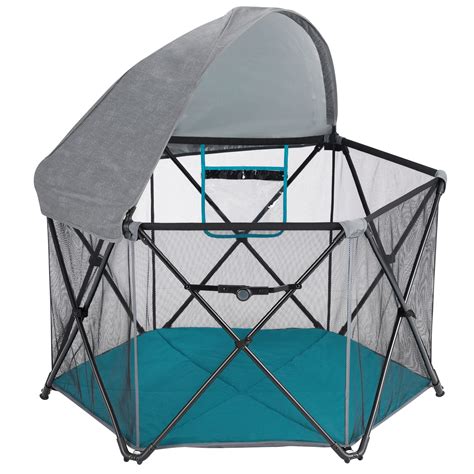As a parent, you understand the importance of providing safe and entertaining spaces for your little ones to play. Pop-up play yards have become increasingly popular as a convenient and portable solution, offering a secure and engaging environment for children to explore. This comprehensive guide will provide you with everything you need to know about pop-up play yards, from their benefits and features to how to choose and set up the perfect one for your family.

What Is a Pop-Up Play Yard?
A pop-up play yard is a portable and foldable enclosure that can be quickly assembled and disassembled. It typically consists of a lightweight frame and durable mesh walls, creating a safe and confined play area for your child. Pop-up play yards are designed to be spacious enough for toddlers to crawl, walk, and play, while providing ample ventilation and visibility for parents.
Benefits of Using a Pop-Up Play Yard
Safety and Confinement:
Pop-up play yards provide a secure and enclosed space where you can supervise your child while allowing them to explore their surroundings safely. The mesh walls prevent toddlers from crawling away or reaching hazardous objects, giving you peace of mind.
Convenience and Portability:
Pop-up play yards are lightweight and easy to fold, making them incredibly portable. They can be conveniently transported in a car or bag, allowing you to set up a safe play area almost anywhere, indoors or outdoors.
Entertainment and Development:
With ample space to move around, pop-up play yards offer an excellent environment for children’s physical and cognitive development. They can stimulate gross motor skills, encourage curiosity, and provide opportunities for imaginative play.
Features to Consider When Choosing a Pop-Up Play Yard
Size and Shape:
Choose a play yard that is large enough to accommodate your child’s age and activity level. Consider the shape that best fits your space and needs, such as square, rectangular, or hexagonal.
Mesh Walls and Visibility:
Look for play yards with durable and breathable mesh walls that provide clear visibility for both the child and parents. This allows you to easily monitor your child and ensures proper airflow.
Stability and Safety Features:
Select a play yard with a sturdy frame and non-slip base to ensure stability. Consider models with rounded corners and padded edges for added safety.
Portability and Weight:
If portability is important, opt for a play yard that is lightweight and folds easily. Check the weight and dimensions to ensure it is convenient for you to carry and store.
How to Set Up a Pop-Up Play Yard
Setting up a pop-up play yard is quick and effortless. Here’s a step-by-step guide:
- Unfold the frame: Open the play yard frame by unfolding the hinges until it is completely extended.
- Raise the walls: Grasp the mesh walls and pull them up one section at a time, attaching them to the frame with the provided clips or connectors.
- Secure the base: If necessary, place a non-slip mat or carpet underneath the play yard to enhance stability.
- Add toys and accessories: Place your child’s favorite toys, blankets, and other accessories inside the play yard to create a fun and engaging space.
Potential Applications for Pop-Up Play Yards
Beyond providing a safe play area for children, pop-up play yards can also be used for a variety of other innovative applications:
Pet containment: Use a play yard to create a temporary and secure area for your furry friends to play and roam around safely.
Gardening enclosure: Protect your seedlings and young plants from pests and harsh weather by surrounding them with a pop-up play yard.
Beach or park canopy: Set up a play yard at the beach or park to provide shade and protection from sun, wind, or insects.
Table 1: Comparison of Sizes and Shapes of Pop-Up Play Yards
| Size and Shape | Dimensions (L x W x H) | Suitable for Ages |
|---|---|---|
| Square | 36″ x 36″ x 24″ | 0-2 years |
| Rectangular | 48″ x 24″ x 24″ | 0-3 years |
| Hexagonal | 48″ x 48″ x 24″ | 0-4 years |
Table 2: Factors to Consider When Purchasing a Pop-Up Play Yard
| Factor | Considerations |
|---|---|
| Age and Size | Choose a play yard appropriate for your child’s age and mobility. |
| Safety | Opt for a play yard with sturdy construction, non-slip base, and padded edges. |
| Visibility | Ensure the mesh walls provide clear visibility for both the child and parents. |
| Portability | Select a lightweight and foldable play yard for easy transportation. |
| Durability | Look for play yards made with high-quality materials that will withstand wear and tear. |
Table 3: Pros and Cons of Pop-Up Play Yards
| Pros | Cons |
|---|---|
| Safety and confinement | Potential for tripping hazards on the frame |
| Convenience and portability | May not be suitable for older, more active children |
| Entertainment and development | Can be challenging to clean and maintain |
| Affordable and widely available | May not be as spacious as traditional playpens |
Table 4: Additional Tips and Tricks for Using Pop-Up Play Yards
| Tip | Trick |
|---|---|
| Maximize visibility | Place the play yard near a window or in a well-lit area. |
| Create a stimulating environment | Add toys, books, and other engaging objects to encourage play. |
| Use a cover or shade | Protect your child from sun or insects by covering the play yard with a canopy or sheet. |
| Place on a soft surface | Consider placing a blanket or cushion inside the play yard for added comfort. |
